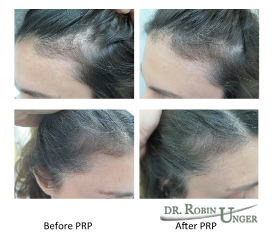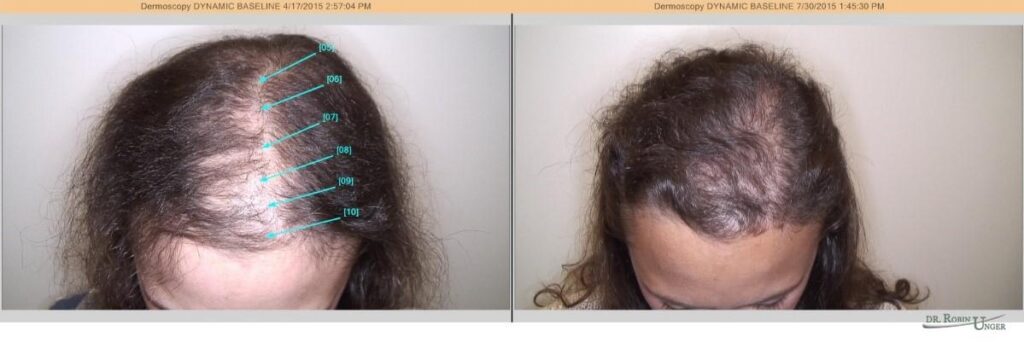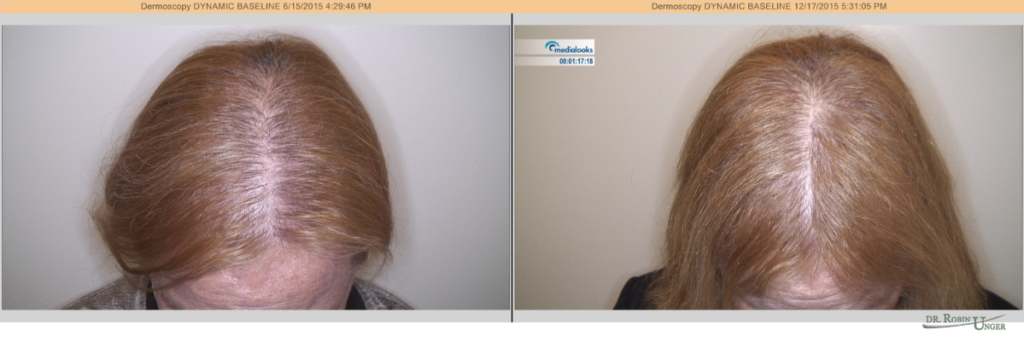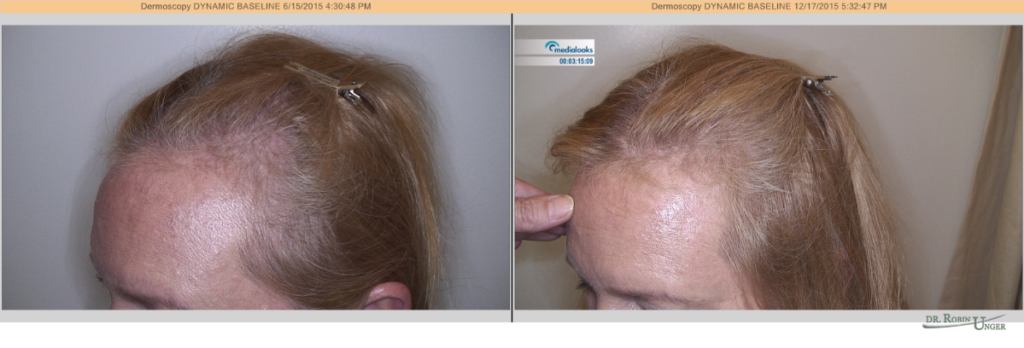PRP For Hair Loss Patients
Platelet rich plasma treatment, is a technique that involves using your own filtered blood to stimulate hair growth. The blood is filtered so that only the platelet rich portion remains, and then the plasma is introduced to the scalp via a small needle.
Dr. Unger’s PRP Process
Dr. Unger and Dr. Williams perform the PRP procedure differently than most other hair restoration doctors. To begin with, we use a special set of photographs to perform initial evaluations. These photos allow for a detailed pre- and post-procedure evaluation, so both the patient and doctor can assess the results. Then the blood draw is performed and that IV is utilized to administer some sedation prior to starting the procedure, to make it more comfortable and pleasant for the patients. The entire region to be treated is then numbed using a local anesthetic. Although these initial injections are felt by the patient, most people find them very easily tolerated and the rest of the procedure is pain free.
Microneedling
Microneedling is performed to create micro-trauma in the region being treated with the PRP and this initiates the patient’s own healing mechanisms. The microneedling is performed very carefully to ensure no damage is done to the pre-existing hair in the area. Then ACell is added to the PRP preparation and this solution is injected into the treatment area. The proteins in the blood plasma help encourage new hair growth.
PRP for hair loss can be used alone or as part of a hair transplant process to promote additional hair growth. It can help thicken already existing hair.
We do want to emphasize that this is not a proven treatment for hair loss, but rather an option to be considered when other proven methods of treatment are ineffective or contraindicated.
It is important to recognize that each practitioner offering “PRP treatment” may be describing very different procedures. Evidence at this point is largely anecdotal; some techniques are reported to be very effective, while others have been more disappointing.
Candidates for Platelet Rich Plasma Treatment
Patients for whom PRP has been effective in our practice include men with male pattern hair loss, women with patterned loss, patients with chronic telogen effluvium, and patients with alopecia areata that has been resistant to other proven treatments.
We are currently working with others in the field to try to create more standardization and to scientifically evaluate the effectiveness of PRP for hair loss Manhattan can rely on.
For more information and to determine whether this is the best treatment for you, we will do a thorough exam, dermoscopy evaluation, and history before determining if this procedure is appropriate for you.
Below are several patients’ before/after results with PRP. It was not the initial treatment offered to any of these patients – however it became a treatment option for different options in each case.
Peri-Menopause Female Pattern Hair Loss (FPHL)

A female aged 43 years old began noticing hair loss at age 20 years. It had worsened since she started peri-menopause prematurely. She had already been on minoxidil for almost one year with no improvement and continued shedding. Although PRP for female pattern hair loss is not a proven treatment, she felt she had few options and wanted to proceed. The results shown below are after one PRP treatment at 3 months and 4 months. She has maintained continued growth and cessation of shedding now for 10 months.
Alopecia Areata

A female, aged 24 years at presentation, had been under treatment by several dermatologists for alopecia areata for 18 months. Treatment protocols had included injections of steroids (kenalog) spironolactone, minoxidil, topical steroid solution (clobetasol), ketoconazole shampoo, doxycycline, B-complex injections. Her areas of loss had not improved and her scalp was very red and tender and the patient was very distressed. After initially stopping everything, Dr. Unger was able to achieve re-growth with only steroid injections every 3-4 weeks. However, whenever the steroid injections were tapered, the alopecia areata would become active again.
After trying these various proven techniques for over three years, and with fully informed consent that the PRP has not been proven effective against the disease, the patient and her mother decided to try a novel approach. Currently, the patient has been free of any treatment other than PRP for 10 months. The PRP was initially done 3 times at one month intervals and was repeated after a 3 month interval because the patient reported feeling some tingling which precedes her hair loss, although none was evident at the time of her visit.
Female Pattern Hair Loss (FPHL)


This woman aged 53 years had also tried proven treatments for female pattern hair loss (FPHL) without success, including minoxidil. Her donor hair was exceptionally fine and sparse and thus she was also a poor surgical candidate. PRP treatment was performed along the part-line and in the frontal zone. Her results after six months are shown below. She has a significant amount of new growth hair already measuring approximately 4-5cm in length.
Male Pattern Hair Loss (MPB)


This male patient aged 47 years , had several FUE procedures to the frontal 2/3 of his scalp. His donor hair on the scalp was already depleted and further FUE was not possible. He had already been on Propecia for 15 years and he felt it was no longer so effective. He continued his Propecia, but we performed two PRP sessions three months apart covering first the posterior and then the frontal scalp regions. His results are shown above at 9 months after the first and six months after the second PRP sessions.
PRP for Early Hair Loss

This male patient is 29 years old. He was encouraged to try either minoxidil 5% or finasteride 1mg – both proven treatments for male pattern hair loss that are particularly effective for the vertex region. He felt he would be unable to remain compliant with daily use of minoxidil and did not want to take an androgen modulator. He had PRP for hair loss performed in the posterior region of the scalp and the excellent results are seen only three months later.
Schedule Your PRP Consultation Today
Ready to take the next step in addressing your hair loss? Dr. Robin Unger and Dr. Williams specialize in PRP treatments that have helped many regain confidence with encouraging results. To see if you’re a good candidate for PRP and to discuss the best treatment options for you, schedule your consultation today. Dr. Unger and Dr. Williams are committed to providing tailored care and exploring all possible avenues to help you achieve the best possible outcomes. Don’t wait—reach out now to learn how PRP might be the solution you’ve been seeking.
Client Review
” I’m incredibly pleased with the results of my PRP treatment so far, and am certainly looking forward to seeing what the future holds. For anyone else battling hair loss, I highly recommend that you consult with Dr. Robin Unger – it is well worth the travel to NYC!”
Stephen Ford




